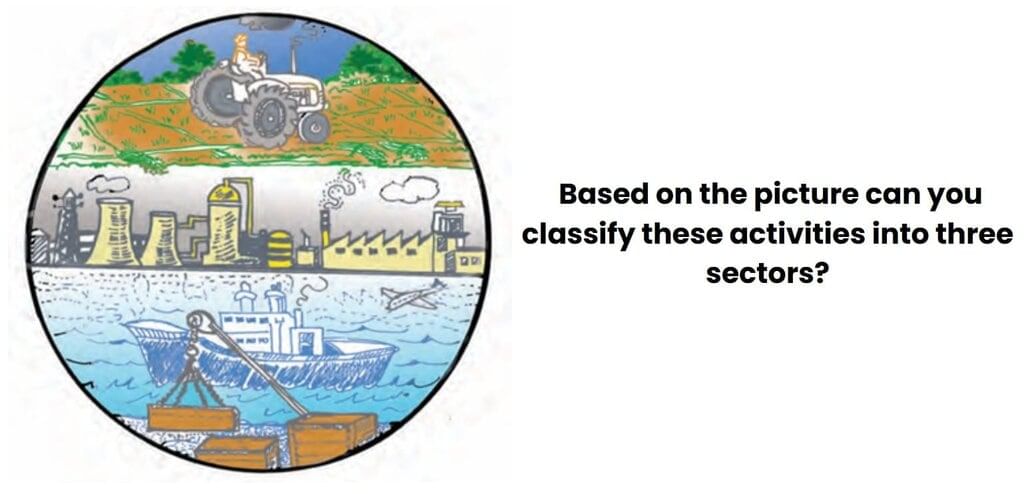Class 9 Economics Chapter 2 Notes - People as Resource
| Table of contents |

|
| Introduction |

|
| Case Studies: Sakal and Vilas |

|
| Economic Activities by Men and Women |

|
| Quality of Population |

|
| Unemployment |

|
| Story of a Village |

|
| Key Terms |

|
Introduction
This chapter explains how population can be an asset (something valuable) rather than a burden for a country.
- When people get education, training, and medical care, they become human capital — a useful resource for the economy.
- Human capital means the skills, knowledge, and abilities that people use to work and earn a living.
- It is created by investing in education, healthcare, and skill development.
- Just like machines and buildings (called physical capital), investing in people also brings benefits.
- Skilled and healthy people can work more efficiently and produce more.
- These working people help increase the country’s income, known as the Gross National Product (GNP).
- So, population is not just about how many people need food and jobs, but also about how many can contribute to development.
- When we spend on education, healthcare, and training:
a) People get better jobs
b) They earn higher incomes
c) They become more productive
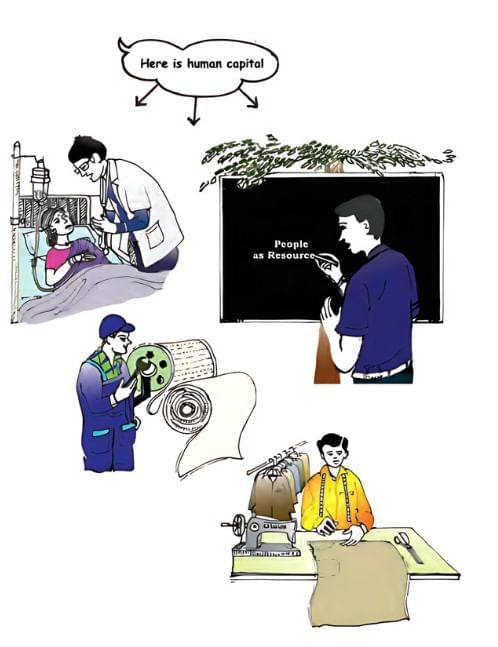 Investing in People Means Investing in Progress
Investing in People Means Investing in Progress
- Educated and healthy people also help others in society by sharing their knowledge and contributing to progress. So, not only individuals but the whole society benefits.
- Land and machines cannot work on their own. But people (human capital) can use land and machines to produce goods and services. This makes human capital more important than land or tools.
- For many years, India’s large population was seen as a problem. Now we understand that it can be a strength if:
- People are educated and healthy
- Workers are trained to use modern methods
- Scientific research is promoted - A population becomes a productive asset when we invest in human capital.
Examples:
The Green Revolution in India demonstrated how scientific knowledge and training can improve agricultural productivity.The IT Revolution showcased the role of educated youth in placing India on the global map as a hub for software and technology services.
Case Studies: Sakal and Vilas
Sakal's Story
- Sakal and Vilas were two friends who lived in a village called Semapur.
- Sakal was 12 years old. His mother, Sheela, took care of household work, and his father, Buta Chaudhary, worked in the fields.
- Sakal helped his mother at home and also took care of his younger siblings, Jeetu and Seetu.
- His uncle, Shyam, had passed Class 10 but was unemployed.
- Sakal's parents wanted him to get a good education, so they made sure he joined the village school.
- He studied well and passed his higher secondary (Class 12) exams.
- His father encouraged him to study further and took a loan so Sakal could learn computers through a vocational course.
- Sakal was a bright and hardworking student. He completed the course with great enthusiasm.
- Soon, he got a job in a private company. There, he designed a special kind of software that helped the company increase its sales.
- His boss appreciated his work and gave him a promotion.
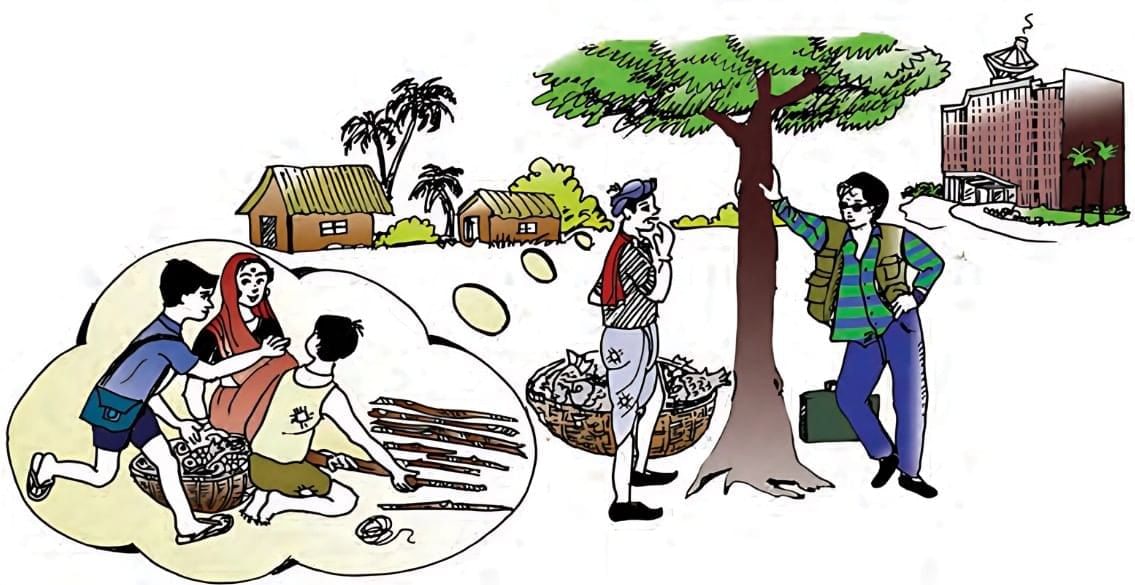 Stories of Vilas and Sakal
Stories of Vilas and Sakal
Vilas’s Story
- Vilas was 11 years old and lived in the same village as Sakal.
- His father, Mahesh, was a fisherman but died when Vilas was just 2 years old.
- His mother, Geeta, sold fish to earn money. She used to buy fish from a landowner’s pond and sell it in the market.
- She earned only around ₹150 a day.
- Vilas had arthritis, a joint disease, but his mother couldn’t afford treatment.
- He never went to school and had no interest in studies.
- Vilas helped his mother with housework and looked after his younger brother, Mohan.
- Later, his mother also became ill and couldn’t take care of the family.
- Since there was no one to help them, Vilas had to start selling fish like his mother.
- He earned only a small amount of money and continued living a hard life.
What Do We Learn from Sakal and Vilas’s Stories?
- Sakal went to school, got good health care, and was healthy. He didn’t need to visit the doctor often.
- Vilas, on the other hand, was sick with arthritis and couldn’t afford to see a doctor. He never went to school.
- Sakal studied computer programming and got a job in a private company. Vilas continued doing what his mother did—selling fish and earning very little money.
- Because Sakal got an education, he became skilled. This increased his productivity (how much useful work he could do), which helped in the growth of the economy.
- Higher productivity means people can earn better salaries or income.
- Vilas did not get any education or health care, so he stayed unskilled and poor, earning the same low income as his mother.
Why Are Education and Health Important?
- When we invest in people by giving them education and medical care, they become more skilled and healthy.
- This helps them earn more money in the future and contribute better to society—just like how investing in land or machines brings returns.
- Even a child, if given proper education and healthcare, can grow up to earn more and help society.
- Educated parents understand the value of education and health. They make sure their children go to school, eat nutritious food and stay clean and healthy.
- This creates a positive cycle—one generation helps the next do better.
In a virtuous cycle, educated and healthy parents raise educated and healthy children.
In a vicious cycle, uneducated and poor parents are unable to support their children well, who also remain uneducated and unhealthy.
Example: Japan
- Japan became rich and developed not because it had natural resources, but because it invested in its people—especially in education and health.
- The educated and skilled people of Japan used other resources, like land and capital, very efficiently.
- This smart use of people and technology made Japan a rich and developed country, even though it had to import natural resources.
Economic Activities by Men and Women
Just like Sakal and Vilas, people around us do different kinds of work. Vilas sold fish, while Sakal worked in an office. All types of work can be divided into three main sectors:
1. Primary Sector
- This includes work like farming, fishing, forestry, mining, poultry, and animal rearing.
- These jobs use natural resources directly.
2. Secondary Sector
- This includes manufacturing and factory work.
- Raw materials are changed into finished goods here.
3. Tertiary Sector
- This includes services like transport, trade, banking, education, health, tourism, communication, insurance, etc.
- These activities help produce goods and services and add to the country's national income.

What Are Economic Activities?
Economic activities are those that produce goods or services and add value to the economy.
They are of two types:
a. Market Activities: Work done for money or profit. Example: Government jobs, business, or private firm jobs.
b. Non-Market Activities: Work done for self-use or without payment. Example: A farmer growing food just for family use or building your own house.
Work Done by Men and Women
- In most families, there is a division of work between men and women:
a) Women, like Sakal’s mother, Sheela, usually take care of the house — cooking, cleaning, looking after children, etc.
b) Men, like Sakal’s father Buta, work outside, earn money, and support the family. The work women do at home is important, but unpaid. That’s why it is not counted in the country’s income.
When Are Women Paid?
- Women get paid when they work outside, like Vilas’s mother, Geeta, who sold fish.
- Their income, like men’s, depends on their education and skills.
Education and Income
- People who are educated and skilled get better jobs and higher pay.
- Most women in India have less education and fewer skills, so:
- They get less pay than men.
- They work in places with no job security.
- They have no maternity leave, no childcare, and no social security. - But when women are well-educated and skilled, they:
- Get jobs with equal pay as men.
- Work in good sectors like teaching, medicine, and sometimes in government and scientific jobs.
Primary Sector (Activities that involve the use of natural resources):
Farming (shown by the tractor working in the field at the top)
Secondary Sector (Activities that involve manufacturing or processing):
Industrial work or factory production (shown in the middle part with factories and chimneys)
Tertiary Sector (Activities that provide services):
Transport and trade (shown by the cargo ship, airplane, and port at the bottom)
Quality of Population
The quality of a country’s population depends on Literacy Rate, Life Expectancy, Health Status, and Skill Formation. A high-quality population is considered an asset. A literate, skilled, and healthy population contributes positively to society and the economy.
Education
Education enhances national income, cultural richness, and governance efficiency.
- Efforts include universal access, retention, and quality in elementary education, with special emphasis on girls.
- Establishment of pace-setting schools like Navodaya Vidyalaya in each district.
- Development of vocational streams for high school students.
Budgetary Allocations and Expenditure
- Plan outlay on education increased from Rs 151 crore in the first plan to Rs 99,300 crore in 2020–21.
- Expenditure on education as a percentage of GDP rose from 0.64% in 1951–52 to 3.1% in 2019–20 (B.E.).
- However, there is a decline to 2.8% in 2020–21 (B.E.), as per the Budget Documents of Union State Governments and the Reserve Bank of India.
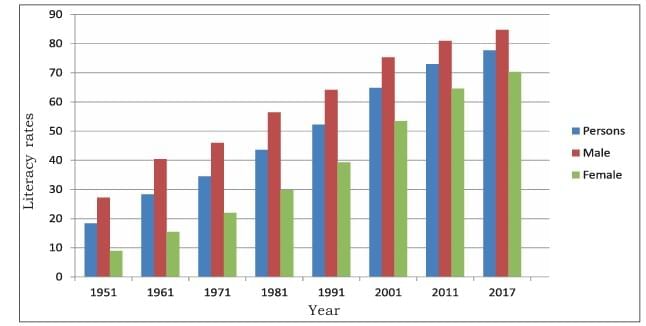 Trends in Literacy Rates In Post - Independent India
Trends in Literacy Rates In Post - Independent India
Literacy Rates and Disparities
- Over the years, literacy rates have shown a commendable upward trend, reaching 85% in 2018.
- Literacy is acknowledged not just as a fundamental right but also as a prerequisite for citizens to effectively fulfil their duties and enjoy their rights.
- However, gender and regional disparities persist, with males exhibiting a 16.1% higher literacy rate than females.
- Urban areas also show a 14.2% advantage over rural areas, emphasizing the need for targeted interventions to bridge these gaps.
Challenges in Primary Education
- While the expansion of the primary school system to over 7.78 lakh in 2019–20 reflects a positive stride, concerns arise over the dilution of educational quality and high dropout rates.
- The implementation of initiatives like Sarva Siksha Abhiyan, with elements such as bridge courses, back-to-school camps, and the mid-day meal scheme, aims to counter these challenges, striving for universal elementary education.
Higher Education Scenario
- In the realm of higher education, the Gross Enrolment Ratio (GER) for the age group of 18 to 23 years reached 27% in 2019–20, aligning broadly with the world average.
- The strategic focus revolves around increasing access, ensuring quality, modifying curricula to suit state-specific needs, encouraging vocationalization, and embracing information technology.
- Noteworthy is the emphasis on distance education and the convergence of various education formats, encompassing formal, non-formal, distance, and IT education institutions.
Health
- In the pursuit of profit maximization, firms place a significant emphasis on workforce efficiency.
- The selection of employees with optimal health is crucial for ensuring productivity and achieving organizational goals.
- The premise is that individuals in good health are better positioned to contribute effectively to the overall growth and success of the organization.
Significance of Health
- Good health enables individuals to realize their potential and effectively contribute to organizational growth.
- Healthy individuals can maximize their output, positively impacting overall organizational performance.
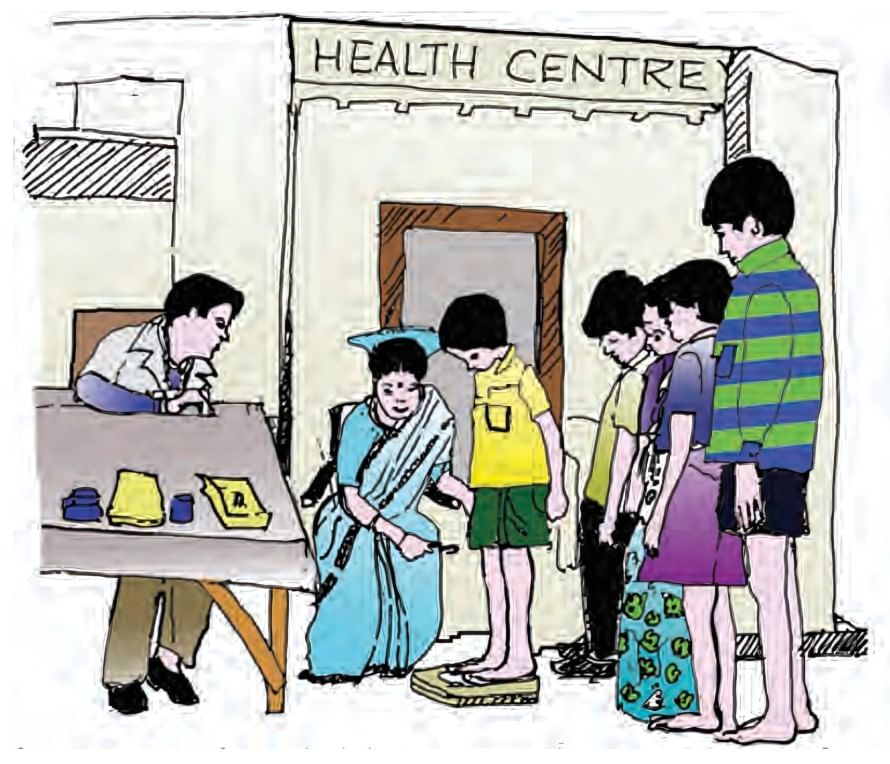 Children standing in queue for health check-up
Children standing in queue for health check-up
Health Infrastructure in India
- National Policy Focus: The national policy emphasizes improving healthcare access and services, focusing on the underprivileged.
- Infrastructure Development: Over the last five decades, India has built extensive health infrastructure in the government and private sectors. Manpower development spans primary, secondary, and tertiary sectors.
Health Progress Indicators
- Life Expectancy: Increased life expectancy to over 67.2 years in 2021.
- Infant Mortality Rate (IMR): IMR reduced from 147 in 1951 to 28 in 2020.
- Crude Birth Rates: Dropped to 20.0 (2018).
- Death Rates: Reduced to 6 (2020).
Healthcare Disparities and Infrastructure Gaps
- Despite progress, healthcare disparities persist in various regions of India. Many areas lack even basic healthcare facilities.
- The availability of medical and dental colleges is unevenly distributed, with only 542 medical colleges and 313 dental colleges nationwide.
- States such as Andhra Pradesh, Karnataka, Maharashtra, and Tamil Nadu host a concentration of medical colleges, revealing regional imbalances in healthcare infrastructure.
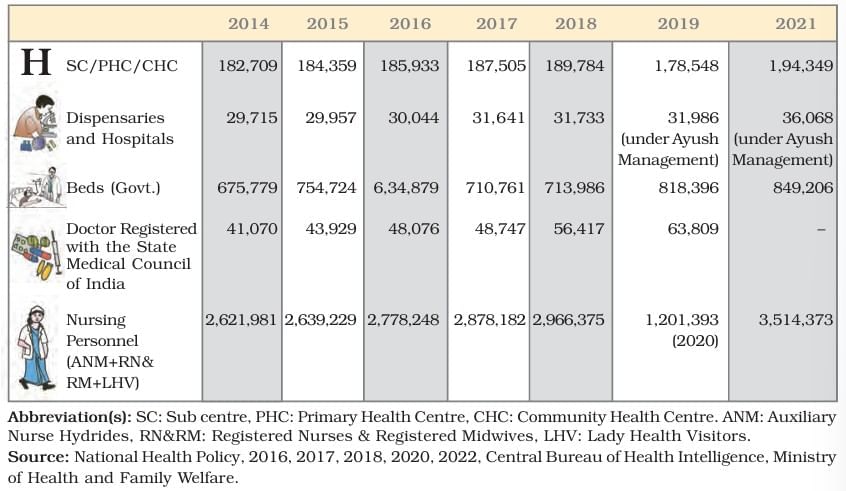 Health infratructure over the years
Health infratructure over the years
Unemployment
Unemployment is characterized by the inability of willing individuals to secure jobs at prevailing wages. It is crucial to differentiate between those not seeking employment and those facing challenges in finding suitable opportunities. In India, both rural and city areas face unemployment, but the reasons differ.
Impact of Unemployment
- Wastage of Manpower Resource: Converts potential assets into liabilities for the economy. Creates a feeling of hopelessness and despair among the youth.
- Economic Overload: Increases dependence on the working population. Adversely affects the quality of life for individuals and society.
- Social Consequences: Decline in health status, withdrawal from the school system, and general despair.
- Indicator of a Depressed Economy: An increase in unemployment signals economic challenges.
Types of Unemployment
- Seasonal Unemployment: In rural areas, seasonal unemployment is prevalent, particularly among those dependent on agriculture. Certain months witness reduced agricultural activities, leading to temporary job scarcity for these individuals.
- Disguised Unemployment: Disguised unemployment, common in family-based agricultural settings, gives the appearance of employment. However, surplus workers engage in activities that do not significantly contribute to productivity, highlighting the inefficiencies in resource utilization.
- Educated Unemployment (Urban): Urban areas witness a paradoxical situation where educated individuals, even with matriculation, graduation, or post-graduate degrees, struggle to find suitable employment. This creates a coexistence of surplus manpower in certain categories and a shortage in others.
Statistical Perspective
- While official statistics may indicate low unemployment rates, many individuals with low income and productivity are considered employed.
- Forced work for subsistence rather than by choice is prevalent, contributing to the statistical landscape.
Disguised Unemployment in Agriculture
- The agriculture sector in India experiences disguised unemployment, with self-employment characterized by surplus labour.
- Despite shared work and produce among family members, surplus labour eventually migrates from villages in search of alternative job opportunities.
Sectoral Employment Trends
- Agriculture: Most labor-absorbing; recent decline due to migration to secondary and tertiary sectors.
- Secondary Sector: Small-scale manufacturing as labor-absorbing.
- Tertiary Sector: Growth in new services like biotechnology and IT.
Story of a Village
- Self-Sufficient Village: Families produced food, made clothes, and taught children independently.
Education & Innovation: One family sent their son to agriculture college. The son became an agro-engineer, designed an improved plough, increasing wheat yield. New job of agro-engineer was created. - Economic Growth: Family sold surplus wheat in a neighboring village, earned profit. Success inspired other families to seek better futures for their children.
- Establishment of School: Families requested the panchayat to open a school. A teacher was recruited; all village children began attending school.
- Creation of Tailoring Job: A daughter trained in tailoring, started stitching clothes for villagers. New job of tailor was created, saving farmers' time and increasing farm yield.
- Village Prosperity: Farmers sold surplus produce in village markets. Village, initially with no job opportunities, now had multiple jobs (teacher, tailor, agro-engineer). The rise in human capital led to diverse and modern economic activities.
In conclusion, the chapter “People as a Resource” demonstrates that education and health are crucial in transforming a population into an asset. By investing in human capital, a nation can ensure sustainable development, improve living standards, and reduce poverty and unemployment. The focus should not only be on increasing the number of people employed, but also on improving the quality of employment and the quality of the population.
Key Terms
- Human Capital: A measure of the economic value of an employee's skill set. This concept emphasizes that not all labor is equal and that the quality of employees can be improved by investing in them.
- Vocational Training: Education or training that prepares individuals for specific crafts, trades, or careers at various levels from a trade, a craft, technician, or a professional position in engineering, accountancy, nursing, medicine, architecture, pharmacy, law etc.
- Green Revolution: Refers to a series of research, development, and technology transfer initiatives, occurring between the 1940s and the late 1960s, that increased agriculture production worldwide, particularly in the developing world.
- IT Revolution: Refers to the rapid advancements and widespread adoption of information technology that began in the late 20th century and continues to affect the global economy, communication, and efficiency.
- Market Activities: Economic activities that involve transactions of goods and services for money, contributing directly to the economy.
- Non-Market Activities: Economic activities that do not involve monetary transactions but satisfy personal and family needs, such as subsistence farming or household work.
- Disguised Unemployment: Occurs when more people are engaged in a job than are actually needed to perform the job; these extra people do not increase productivity.
- Educated Unemployment: A situation where individuals with academic and training qualifications cannot find employment at an appropriate level or wage.
- Virtuous and Vicious Cycles: In economics, a virtuous cycle has favorable results while a vicious cycle has detrimental effects. For instance, investment in education can lead to higher incomes, which can lead to more investments in education (virtuous cycle), whereas lack of education can lead to low income and thus less investment in education (vicious cycle).
- Gross Enrollment Ratio (GER): The number of students enrolled in a given level of education, regardless of age, expressed as a percentage of the official school-age population corresponding to the same level of education.
- Navodaya Vidyalaya: A system of central schools for talented students predominantly from rural India. They are run by Navodaya Vidyalaya Samiti, New Delhi, an autonomous organization under the Department of School Education and Literacy, Ministry of Education (MoE), Government of India.
- Sarva Siksha Abhiyan (SSA): A government of India program aimed at the universalization of elementary education in a time-bound manner, as mandated by the 86th amendment to the Constitution of India making free and compulsory education to children aged 6–14 a fundamental right.
- Mid-Day Meal Scheme: A school meal program in India designed to improve the nutritional status of school-age children nationwide.
|
55 videos|635 docs|79 tests
|
FAQs on Class 9 Economics Chapter 2 Notes - People as Resource
| 1. What are the main economic activities performed by men and women? |  |
| 2. How does the quality of the population affect economic development? |  |
| 3. What is the current status of unemployment among men and women? |  |
| 4. What are some common challenges faced by women in the workforce? |  |
| 5. How can improving the quality of the population help reduce unemployment? |  |

